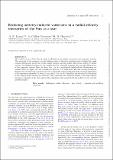Files in this item
Reducing activity-induced variations in a radial-velocity time series of the Sun as a star
Item metadata
| dc.contributor.author | Lanza, A. F. | |
| dc.contributor.author | Collier Cameron, A. | |
| dc.contributor.author | Haywood, R. D. | |
| dc.date.accessioned | 2019-04-22T09:30:02Z | |
| dc.date.available | 2019-04-22T09:30:02Z | |
| dc.date.issued | 2019-07 | |
| dc.identifier | 258600599 | |
| dc.identifier | fe185e1c-1274-48ef-95b4-b97336cf9811 | |
| dc.identifier | 000474903500037 | |
| dc.identifier | 85072273000 | |
| dc.identifier.citation | Lanza , A F , Collier Cameron , A & Haywood , R D 2019 , ' Reducing activity-induced variations in a radial-velocity time series of the Sun as a star ' , Monthly Notices of the Royal Astronomical Society , vol. 486 , no. 3 , pp. 3459–3464 . https://doi.org/10.1093/mnras/stz1055 | en |
| dc.identifier.issn | 0035-8711 | |
| dc.identifier.other | BibCode: 2019arXiv190405608L | |
| dc.identifier.other | ORCID: /0000-0002-8863-7828/work/58531490 | |
| dc.identifier.uri | https://hdl.handle.net/10023/17565 | |
| dc.description | AFL acknowledges support by INAF/Frontiera through the "Progetti Premiali" funding scheme of the Italian Ministry of Education, University, and Research. ACC acknowledges support from the Science & Technology Facilities Council (STFC) consolidated grant number ST/R000824/1. This work was performed in part under contract with the California Institute of Technology (Caltech)/Jet Propulsion Laboratory (JPL) funded by NASA through the Sagan Fellowship Program executed by the NASA Exoplanet Science Institute (R.D.H.). | en |
| dc.description.abstract | The radial velocity of the Sun as a star is affected by its surface convection and magnetic activity. The moments of the cross-correlation function between the solar spectrum and a binary line mask contain information about the stellar radial velocity and line-profile distortions caused by stellar activity. As additional indicators, we consider the disc-averaged magnetic flux and the filling factor of the magnetic regions. Here we show that the activity-induced radial-velocity fluctuations are reduced when we apply a kernel regression to these activity indicators. The disc-averaged magnetic flux proves to be the best activity proxy over a timescale of one month and gives a standard deviation of the regression residuals of 1.04 m/s, more than a factor of 2.8 smaller than the standard deviation of the original radial velocity fluctuations. This result has been achieved thanks to the high-cadence and time continuity of the observations that simultaneously sample both the radial velocity and the activity proxies. | |
| dc.format.extent | 582644 | |
| dc.language.iso | eng | |
| dc.relation.ispartof | Monthly Notices of the Royal Astronomical Society | en |
| dc.subject | Techniques: radial velocities | en |
| dc.subject | Sun: activity | en |
| dc.subject | Planets and satellites: detection | en |
| dc.subject | QB Astronomy | en |
| dc.subject | QC Physics | en |
| dc.subject | 3rd-DAS | en |
| dc.subject.lcc | QB | en |
| dc.subject.lcc | QC | en |
| dc.title | Reducing activity-induced variations in a radial-velocity time series of the Sun as a star | en |
| dc.type | Journal article | en |
| dc.contributor.sponsor | Science & Technology Facilities Council | en |
| dc.contributor.institution | University of St Andrews. School of Physics and Astronomy | en |
| dc.contributor.institution | University of St Andrews. St Andrews Centre for Exoplanet Science | en |
| dc.identifier.doi | https://doi.org/10.1093/mnras/stz1055 | |
| dc.description.status | Peer reviewed | en |
| dc.identifier.url | http://adsabs.harvard.edu/abs/2019arXiv190405608L | en |
| dc.identifier.grantnumber | ST/R00824/1 | en |
This item appears in the following Collection(s)
Items in the St Andrews Research Repository are protected by copyright, with all rights reserved, unless otherwise indicated.

